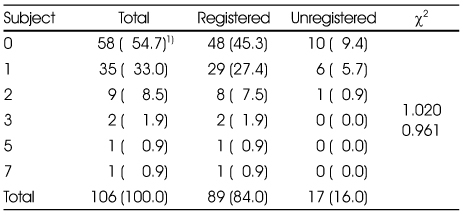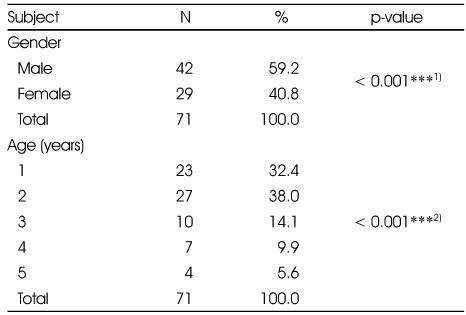Articles
- Page Path
- HOME > Korean J Community Nutr > Volume 20(4); 2015 > Article
-
Research Article
- The Current State of Food Allergy of Preschool Childcare Facilities in Hanam
- Wookyoun Cho, Jinah Kim
-
Korean Journal of Community Nutrition 2015;20(4):251-258.
DOI: https://doi.org/10.5720/kjcn.2015.20.4.251
Published online: August 30, 2015
1Department of Food and Nutrition, College of BioNano Technology, Gachon University, Gyeonggi, Korea.
2Hanam Center for Children's Foodservice Management, Gyeonggi, Korea.
- Corresponding author: Wookyoun Cho. Department of Food and Nutrition, College of BioNano Technology, Gachon University, 1342 Seongnam-daero, Sujeonggu, Seongnam-si, Gyeonggi 13120, Korea. Tel: (031) 750-5972, Fax: (031) 750-5974, wkcho@gachon.ac.kr
Copyright © 2015 The Korean Society of Community Nutrition
This is an Open-Access article distributed under the terms of the Creative Commons Attribution Non-Commercial License (http://creativecommons.org/licenses/by-nc/3.0/) which permits unrestricted non-commercial use, distribution, and reproduction in any medium, provided the original work is properly cited.
- 1,123 Views
- 2 Download
- 5 Crossref
Abstract
-
Objectives
- The purpose of this study was to investigate how to manage food allergy of pre-school children, focusing on the current status of the food allergy in childcare facilities in Hanam which have less than 100 children.
-
Methods
- Targeting 159 preschool childcare facilities, survey was carried out for a month in March, 2015. Recovery rate was 66.7%. 106 surveys out of 159 were available for analysis using SPSS statistical program version 19.0.
-
Results
- Among 106 facilities, 58 (54.7%) reported that none of their children had a food allergy and 48 (45.3%) reported one more children had a food allergy. Total number of children having a food allergy was 71. Among them, the occurrences of food allergy in males were significantly more than that of the females (p < 0.001). Further, children under 2 years of age had significantly more food allergy than the other ages (p < 0.001). The allergic inducing foods were nuts (23.3%), egg (17.8%), milk and dairy products (16.4%), fish and shellfish (13.7%), instant foods (12.3%), fruits (8.2%), soybean (4.1%), meat (2.7%), and cereals (1.4%) in order, and 6 children out of 71 were allergic to more than 2 food items. The clinical symptoms of the food allergy were a skin reaction (87.9%) and an oropharyngeal & respiratory reaction (12.1%). Majority of childcare facilities (80.3%) didn't serve alternative foods for children with food allergy. Necessity for food allergy education was significantly higher in facilities with food allergy issues than without such issues.
-
Conclusions
- The Center for Children's Foodservice Management need to educate workers of childcare facilities and parents about managing food allergy and enforce a plan to provide alternative menu to children with food allergies.
- 1. Seo WH, Jang EY, Han YS, Ahn KM, Jung JT. Management of food allergies in young children at a child care center and hospital in Korean. Pediatr Allergy Respir Dis 2011; 21(1): 32-38.Article
- 2. Ahn K. Food allergy: diagnosis and management. Korean J Asthma Allergy Clin Immunol 2011; 31(3): 163-169.
- 3. Sicherer SH, Sampson HA. Food allergy. J Allergy Clin Immunol 2006; 117(2): S470-S475.PubMed
- 4. Rona RJ, Keil T, Summers C, Gislason D, Zuidmeer L, Sodergren E. The prevalence of food allergy: a metaanalysis. J Allergy Clin Immunol 2007; 120(3): 638-646.ArticlePubMed
- 5. Bock SA, Munoz-Furlong A, Sampson HA. Further fatalities caused by anaphylactic reactions to food, 2001-2006. J Allergy Clin Immunol 2007; 119(4): 1016-1018.ArticlePubMed
- 6. Hong SJ, Ahn KM, Lee SY, Kim KE. The prevalences of asthma and allergic diseases in Korean children. Korean J Pediatr 2008; 51(4): 343-350.Article
- 7. Yonhapnews. 'Dairy allergy' Youth, brain-dead after eating school meals [Internet] Naver. 2013 Apr 09]. Available from: http://news.naver.com/main/read.nhn?mode=LSD&mid=sec&sid1=102&oid=001&aid=0006194640.
- 8. Lee SY, Kim KW, Lee HH, Lim DH, Chung HL, Kim SW. Incidence and clinical characteristics of pediatric emergency department visits of children with severe food allergy. Korean J Asthma Allergy Clin Immunol 2012; 32(3): 169-175.
- 9. Ministry of Education. 2013 Student Health Promotion primary direction [Internet]. 2013; cited 2014 Feb 21]. Available from: http://www.moe.go.kr/.
- 10. Ministry of Health and Welfare. Childcare Business Information. Ministry of Health and Welfare. 2014 Mar. Report No. 11-1352000-000191-10.
- 11. Ministry of Health and Welfare. Childcare Business Information. Ministry of Health & Welfare. 2015 Mar. Report No. 11-1352000-000191-10.
- 12. Korea Childcare Promotion Institute. Korean Childcare Accreditation Information. Korea Childcare Promotion Institute. 2014 Dec. Report No. Korea Childcare Promotion Institute-2014-170.
- 13. Park JY, Park GY, Han YS, Shin MY. Survey of food allergy in elementary school children in Bucheon-city and relationship between food allergy and other allergic diseases. Allergy Asthma Respir Dis 2013; 1(3): 266-273.Article
- 14. Lee HJ. A study on health status and dietary habits among preschool children in Jung-gu [master's thesis]. Seoul: Myongji Universiry; 2010.
- 15. Oh MA. Study on food allergies and dietary behavior and eating habits of the elementary students in Jeonnam [master's thesis]. Chonnam National University: 2015.
- 16. Simons FER. Anaphylaxis: Recent advances in assessment and treatment. J Allergy Clin Immunol 2009; 124(4): 625-636.ArticlePubMed
- 17. Simons FER. Anaphylaxis. J Allergy Clin Immunol 2010; 125: Suppl 2. S161-S181.ArticlePubMed
- 18. Jeon PK, Kwon JY, Hwang EM, Pyun BY. Survey on the Pattern of Food Intake during early childhood and allergic disease. Pediatr Allergy Respir Dis 2003; 13(1): 33-46.
- 19. Sampson HA. Food allergy. Part 1: immunopathogenesis and clinical disorders. J Allergy Clin Immunol 1999; 103(5): 717-728.ArticlePubMed
- 20. Jung YH, Ko H, Kim HY, Seo JH, Kwon JW, Kim BJ. Prevalence and risk factors of food allergy in preschool children in Seoul. Korean J Asthma Allergy Clin Immunol 2011; 31(3): 177-183.
- 21. Ahn HS, Lee SM, Lee MY, Choung JT. A study of the dietary intakes and causative foods in allergic children. Pediatr Allergy Respir Dis 1999; 9(1): 79-92.
- 22. Mofidi S. Nutritional management of pediatric food hypersensitivity. Pediatr 2003; 111: Suppl 3. 1645-1653.ArticlePDF
- 23. Fiocchi A, Martelli A. Dietary management of food allergy. Pediatr Ann 2006; 35(10): 755-756.ArticlePubMed
- 24. Kemp AS. Pediatric allergy : principles and practice. J Paediatr Child Health 2004; 40(3): 159.Article
- 25. Arshad SH. Food allergen avoidance in primary prevention of food allergy. Allergy 2001; 56: Suppl 67. 113-116.ArticlePubMed
- 26. Kim DS, Ban JS, Park EA, Lee JY, Lee JO, Chang EY. Survey of food allergy in elementary school students in Dongjak-gu using questionnaire. Korean J Asthma Allergy Clin Immunol 2011; 31(4): 254-259.
REFERENCES
Figure & Data
REFERENCES
Citations

- Knowledge and management of food allergy by parents of preschool children who experience food allergies
Seung Hui Kim, Seung-Min Lee
Journal of Nutrition and Health.2023; 56(2): 184. CrossRef - Cleaning Methods to Effectively Remove Peanut Allergens from Food Facilities or Utensil Surfaces
Sol-A Kim, Jeong-Eun Lee, Jaemin Shin, Won-Bo Shim
Journal of Food Hygiene and Safety.2023; 38(4): 228. CrossRef - Risk factors for food allergy among children in Seoul: focusing on dietary habits and environmental factors
Mijung Jang, KyooSang Kim
Journal of Nutrition and Health.2019; 52(6): 559. CrossRef - Study on the snack menu pattern, food diversity and satisfaction of parent provided by Center for Children's Foodservice Management in Jeonbuk area
Eun-Byul Sym, Jeong-Ok Rho
Journal of Nutrition and Health.2019; 52(5): 501. CrossRef - Food allergic reactions in the community: a questionnaire survey of caregivers
An Deok Seo, Jun Yeol Lee, Song I Yang, Hye Ran Lee, So-Yeon Lee
Allergy, Asthma & Respiratory Disease.2017; 5(1): 27. CrossRef

Fig. 1
General characteristics of childcare facilities
1) N (%)
**: P < 0.01 significantly different between registered and unregistered facilities by chi square test
Numbers of children with food allergy by childcare facilities
1) N (%)
Occurrences of food allergy in children according to gender and ages
1) Significantly different by independent t-test
2) Significantly different by one way ANOVA
***: P < 0.001
The allergy inducing foods
1) N (%)
Clinical symptoms of food allergy
Principal's recognition of necessity for food allergy education
1) Mean±SD
5-point Likert scale (not needed at all=1, strongly needed=5)
*: P < 0.05 significantly different between facilities with food allergic children and facilities without food allergic children by independent t-test
1) N (%) **: P < 0.01 significantly different between registered and unregistered facilities by chi square test
1) N (%)
1) Significantly different by independent t-test 2) Significantly different by one way ANOVA ***: P < 0.001
1) N (%)
1) Mean±SD 5-point Likert scale (not needed at all=1, strongly needed=5) *: P < 0.05 significantly different between facilities with food allergic children and facilities without food allergic children by independent t-test

 KSCN
KSCN







 Cite
Cite


